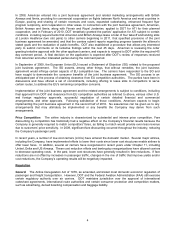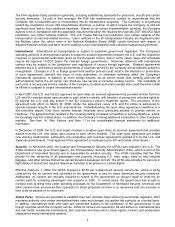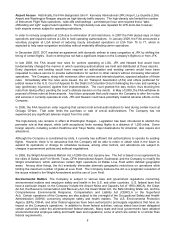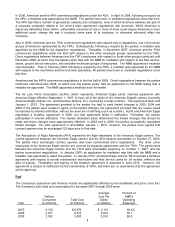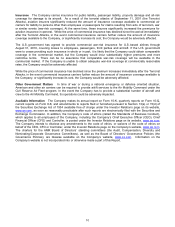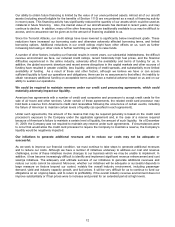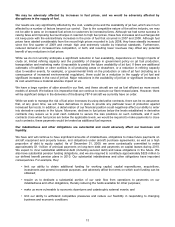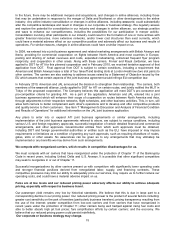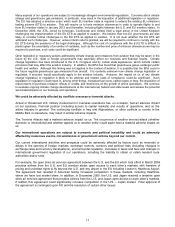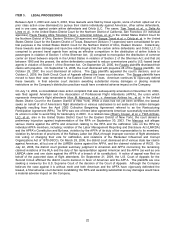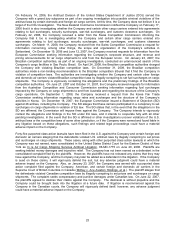American Airlines 2009 Annual Report Download - page 16
Download and view the complete annual report
Please find page 16 of the 2009 American Airlines annual report below. You can navigate through the pages in the report by either clicking on the pages listed below, or by using the keyword search tool below to find specific information within the annual report.
13
We may be adversely affected by increases in fuel prices, and we would be adversely affected by
disruptions in the supply of fuel.
Our results are very significantly affected by the cost, volatile price and the availability of jet fuel, which are in turn
affected by a number of factors beyond our control. Due to the competitive nature of the airline industry, we may
not be able to pass on increased fuel prices to customers by increasing fares. Although we had some success in
raising fares and imposing fuel surcharges in reaction to high fuel prices, these fare increases and surcharges did
not keep pace with the extraordinary increases in the price of fuel that occurred in 2007 and 2008. Although fuel
prices have abated considerably from the record high prices recorded in July 2008, they have steadily increased
since the first quarter of 2009 and remain high and extremely volatile by historical standards. Furthermore,
reduced demand or increased fare competition, or both, and resulting lower revenues may offset any potential
benefit of any reductions in fuel prices.
While we do not currently anticipate a significant reduction in fuel availability, dependence on foreign imports of
crude oil, limited refining capacity and the possibility of changes in government policy on jet fuel production,
transportation and marketing make it impossible to predict the future availability of jet fuel. If there are additional
outbreaks of hostilities or other conflicts in oil producing areas or elsewhere, or a reduction in refining capacity
(due to weather events, for example), or governmental limits on the production or sale of jet fuel (including as a
consequence of increased environmental regulation), there could be a reduction in the supply of jet fuel and
significant increases in the cost of jet fuel. Major reductions in the availability of jet fuel or significant increases in
its cost would have a material adverse impact on us.
We have a large number of older aircraft in our fleet, and these aircraft are not as fuel efficient as more recent
models of aircraft. We believe it is imperative that we continue to execute our fleet renewal plans. However, there
will be significant delays in the deliveries of the Boeing 787-9 aircraft we currently have on order.
While we seek to manage the risk of fuel price increases by using derivative contracts, there can be no assurance
that, at any given time, we will have derivatives in place to provide any particular level of protection against
increased fuel costs. In addition, a deterioration of our financial position could negatively affect our ability to enter
into derivative contracts in the future. Moreover, declines in fuel prices below the levels established in derivative
contracts may require us to post cash collateral to secure the loss positions on such contracts, and if such
contracts close when fuel prices are below the applicable levels, we would be required to make payments to close
such contracts; these payments would be treated as additional fuel expense.
Our indebtedness and other obligations are substantial and could adversely affect our business and
liquidity.
We have and will continue to have significant amounts of indebtedness, obligations to make future payments on
aircraft equipment and property leases, and obligations under aircraft purchase agreements, as well as a high
proportion of debt to equity capital. As of December 31, 2009, we were contractually committed to make
approximately $1.1 billion of principal payments on long-term debt and payments on capital leases during 2010.
We expect to incur substantial additional debt (including secured debt) and lease obligations in the future. We
also have substantial pension funding obligations, and we are required to contribute approximately $525 million to
our defined benefit pension plans in 2010. Our substantial indebtedness and other obligations have important
consequences. For example, they:
•
limit our ability to obtain additional funding for working capital, capital expenditures, acquisitions,
investments and general corporate purposes, and adversely affect the terms on which such funding can be
obtained;
•
require us to dedicate a substantial portion of our cash flow from operations to payments on our
indebtedness and other obligations, thereby reducing the funds available for other purposes;
•
make us more vulnerable to economic downturns and catastrophic external events; and
•
limit our ability to withstand competitive pressures and reduce our flexibility in responding to changing
business and economic conditions.



